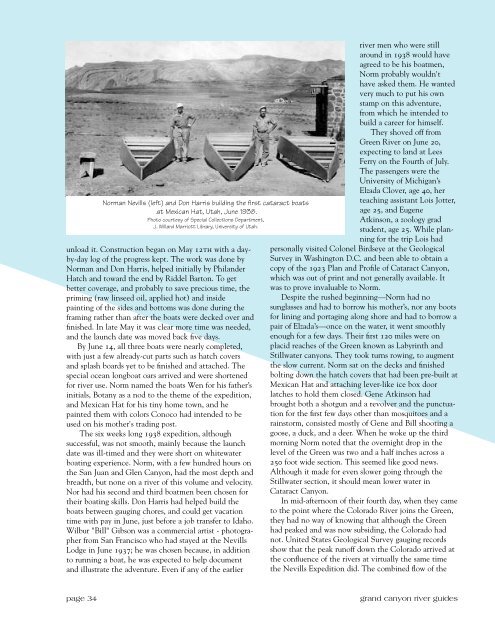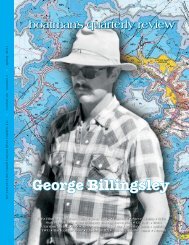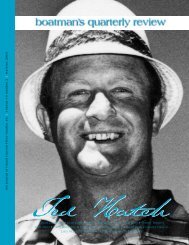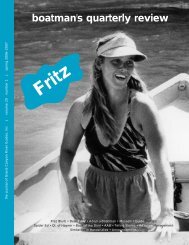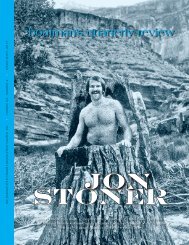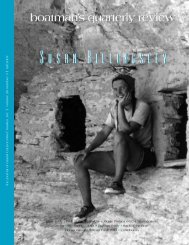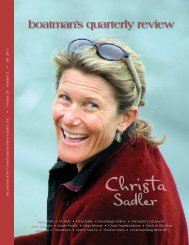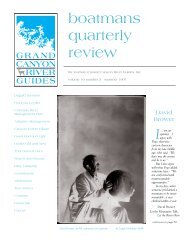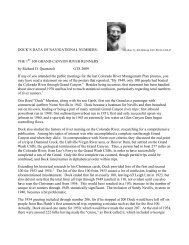spring 04 / 17:1 - Grand Canyon River Guides
spring 04 / 17:1 - Grand Canyon River Guides
spring 04 / 17:1 - Grand Canyon River Guides
You also want an ePaper? Increase the reach of your titles
YUMPU automatically turns print PDFs into web optimized ePapers that Google loves.
Norman Nevills (left) and Don Harris building the first cataract boats<br />
at Mexican Hat, Utah, June 1938.<br />
Photo courtesy of Special Collections Department,<br />
J. Willard Marriott Library, University of Utah.<br />
unload it. Construction began on May 12th with a dayby-day<br />
log of the progress kept. The work was done by<br />
Norman and Don Harris, helped initially by Philander<br />
Hatch and toward the end by Riddel Barton. To get<br />
better coverage, and probably to save precious time, the<br />
priming (raw linseed oil, applied hot) and inside<br />
painting of the sides and bottoms was done during the<br />
framing rather than after the boats were decked over and<br />
finished. In late May it was clear more time was needed,<br />
and the launch date was moved back five days.<br />
By June 14, all three boats were nearly completed,<br />
with just a few already-cut parts such as hatch covers<br />
and splash boards yet to be finished and attached. The<br />
special ocean longboat oars arrived and were shortened<br />
for river use. Norm named the boats Wen for his father’s<br />
initials, Botany as a nod to the theme of the expedition,<br />
and Mexican Hat for his tiny home town, and he<br />
painted them with colors Conoco had intended to be<br />
used on his mother's trading post.<br />
The six weeks long 1938 expedition, although<br />
successful, was not smooth, mainly because the launch<br />
date was ill-timed and they were short on whitewater<br />
boating experience. Norm, with a few hundred hours on<br />
the San Juan and Glen <strong>Canyon</strong>, had the most depth and<br />
breadth, but none on a river of this volume and velocity.<br />
Nor had his second and third boatmen been chosen for<br />
their boating skills. Don Harris had helped build the<br />
boats between gauging chores, and could get vacation<br />
time with pay in June, just before a job transfer to Idaho.<br />
Wilbur "Bill" Gibson was a commercial artist - photographer<br />
from San Francisco who had stayed at the Nevills<br />
Lodge in June 1937; he was chosen because, in addition<br />
to running a boat, he was expected to help document<br />
and illustrate the adventure. Even if any of the earlier<br />
river men who were still<br />
around in 1938 would have<br />
agreed to be his boatmen,<br />
Norm probably wouldn't<br />
have asked them. He wanted<br />
very much to put his own<br />
stamp on this adventure,<br />
from which he intended to<br />
build a career for himself.<br />
They shoved off from<br />
Green <strong>River</strong> on June 20,<br />
expecting to land at Lees<br />
Ferry on the Fourth of July.<br />
The passengers were the<br />
University of Michigan’s<br />
Elzada Clover, age 40, her<br />
teaching assistant Lois Jotter,<br />
age 25, and Eugene<br />
Atkinson, a zoology grad<br />
student, age 25. While planning<br />
for the trip Lois had<br />
personally visited Colonel Birdseye at the Geological<br />
Survey in Washington D.C. and been able to obtain a<br />
copy of the 1923 Plan and Profile of Cataract <strong>Canyon</strong>,<br />
which was out of print and not generally available. It<br />
was to prove invaluable to Norm.<br />
Despite the rushed beginning—Norm had no<br />
sunglasses and had to borrow his mother’s, nor any boots<br />
for lining and portaging along shore and had to borrow a<br />
pair of Elzada’s—once on the water, it went smoothly<br />
enough for a few days. Their first 120 miles were on<br />
placid reaches of the Green known as Labyrinth and<br />
Stillwater canyons. They took turns rowing, to augment<br />
the slow current. Norm sat on the decks and finished<br />
bolting down the hatch covers that had been pre-built at<br />
Mexican Hat and attaching lever-like ice box door<br />
latches to hold them closed. Gene Atkinson had<br />
brought both a shotgun and a revolver and the punctuation<br />
for the first few days other than mosquitoes and a<br />
rainstorm, consisted mostly of Gene and Bill shooting a<br />
goose, a duck, and a deer. When he woke up the third<br />
morning Norm noted that the overnight drop in the<br />
level of the Green was two and a half inches across a<br />
250 foot wide section. This seemed like good news.<br />
Although it made for even slower going through the<br />
Stillwater section, it should mean lower water in<br />
Cataract <strong>Canyon</strong>.<br />
In mid-afternoon of their fourth day, when they came<br />
to the point where the Colorado <strong>River</strong> joins the Green,<br />
they had no way of knowing that although the Green<br />
had peaked and was now subsiding, the Colorado had<br />
not. United States Geological Survey gauging records<br />
show that the peak runoff down the Colorado arrived at<br />
the confluence of the rivers at virtually the same time<br />
the Nevills Expedition did. The combined flow of the<br />
page 34<br />
grand canyon river guides


